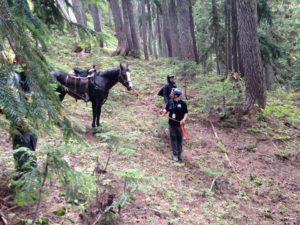
On August 28, 2016 we deployed very early in the morning to help with a horse down an embankment. The call originally came to search and rescue as a rider injured, so Seattle Mountain Rescue (SMR) and Explorer Search and Rescue (ESAR) deployed in the dark to head up the 4.5+ miles up the beginning of Section J of the Pacific Crest Trail. They knew the rider was uninjured and back at the campsite she, her husband, and a friend had set up. The teams went to check on the owner, evaluate the horse situation, as well as escort the rider’s friend up with overnight supplies. They arrived to find a horse and rider had run into a bit of bad luck and slipped off the trail earlier in the day.
One of the ESAR volunteers is also a WASART volunteer, so he was able to help advise. The horse seemed uninjured and in good health, and the rider seemed alright as well, so they determined they’d try early in the morning to try to extract the horse via plan A and call for more help if their plan didn’t work out. The ESAR and SMR responders spent a cold and damp night near the horse.
Plan A is almost always to try to walk the horse out through a more shallow route. Plan B was to help the horse down the steep remaining 20 feet before the ground leveled out with the help of a rear assist. Plan C, if neither of those worked, would be to sedate the horse, wrap her in our rescue glide, set up a rope system, and haul her up.
Though there were no obvious injuries, the horse was not willing to move in the morning and the search and rescue operations leader gave the okay to call us in. We’d been made aware of the situation the night before and had members ready for the call at 5 a.m.
We headed out, picked up the van and all met at the trailhead about 9:30 a.m. Already on site were other assisting agencies, including the Incident Support Team, who handle radios and paperwork, and Dr. Dana Westerman, who was just setting out to attend the horse. (As an aside, if you have a vet who is willing to hike over 9 miles round trip and attend her, you know you have someone amazing.)
We grabbed equipment we’d need in case it came to plan C, which included heavy rope bags and the even heavier and awkward Rescue Glide that is one of our number one tools in rescuing livestock.
As we left we got word the Northwest Horseback Search and Rescue Team were being called in as well, which meant additional equipment that may be needed could be packed in on the horses. In addition, it meant they’d be available for the hike back out.
The hike up meant finding a way to make the awkward glide less awkward, which ended up being to bend and strap it into a taco shape and have one or two people pulling from the front and another in the rear holding onto a tag line to keep it from drifting down hill.
The hike itself was always at an incline or a decline and looking at the charts for the Pacific Crest trail, the section we traveled was about 2500 elevation gain.
At the top, we found all the agencies working together to make a plan that would be safest and best for everyone involved. The horse, Tia, was about 100 feet down a 45 degree slope. Plan C was determined to not be safe, as the trail was too narrow to allow for the horse to get out of the glide safely. Fortunately, it looked like plan A combined with plan B would work best, where the horse could be walked out at the route with the least incline after being helped down the first 20 feet with the rear assist.
Crews began to find that path and mark it with grid tape, which is a florescent ribbon used for marking trees. Other responders cleared logs and other obstacles with chainsaws, tools, or brawn while WASART responder JC gained Tia’s trust and coaxed her forward a tiny step at time. She was hesitant and shook with each step but gradually got better as she moved.
Much of the team followed at a distance to not spook Tia, but to be on hand in case they were needed as well as collect the grid tape markers. Tia and the responders walked through the woods and clearings and eventually met up with the trail about a mile downhill of where they started.
Tia and her owner, handlers, and Dr. Dana continued back to the parking lot, and the rest of the team hiked back to help carry gear back out. Most was loaded onto the packhorses, for which we are very grateful – we were all very tired at that point. The one piece we had to carry down was the glide. It was too large and made too much noise and would likely spook the patient packhorses, so we took turns wrestling the glide back down the hill.
At the bottom, we were met by The Soup Ladies, a non-profit volunteer organization who are called in to larger responses to serve amazing home cooked soups to responders.
While we recovered with soup and bread, Tia munched on hay and looked to be doing well.

 Lars East, a Friesian with Arthritic Hips
Lars East, a Friesian with Arthritic Hips